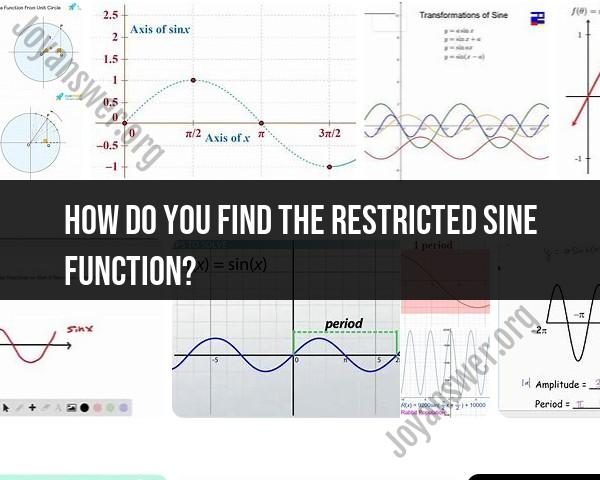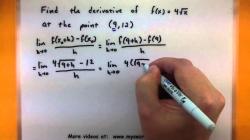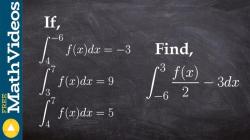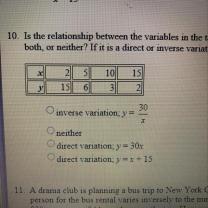How do you find the restricted sine function?
A restricted sine function is essentially a sine function constrained within a certain domain or interval. The typical sine function has a periodic nature and extends infinitely in both directions along the x-axis. However, a restricted sine function limits this behavior within a specific range or interval.
Finding the Restricted Sine Function:
To find a restricted sine function within a specific interval, you'll generally do the following:
Define the Interval: Determine the range over which you want to restrict the sine function, such as .
Restrict the Domain: Modify the standard sine function by restricting the domain to the specified interval.
For instance, if you want to restrict the sine function to the interval , the restricted sine function within that interval can be written as:
Example:
Let's say you want to find the restricted sine function within the interval :
The restricted sine function within this interval will be:
This means you're considering the standard sine function but only within the range from to on the x-axis.
Visualization:
To visualize this in MATLAB, for instance, you can plot the standard sine function and then restrict it to the desired interval by setting the x-axis limits.
x = linspace(-2*pi, 2*pi, 1000); % Define x from -2pi to 2pi
y = sin(x); % Standard sine function
% Plot the standard sine function
figure;
plot(x, y, 'b'); % Plot in blue
% Restrict the plot to the interval -2pi to 2pi
xlim([-2*pi, 2*pi]);
% Customize plot labels and title
xlabel('x');
ylabel('y = sin(x)');
title('Restricted Sine Function: -2pi <= x <= 2pi');
grid on;
This MATLAB code will plot the standard sine function and restrict it to the interval on the x-axis.
You can modify the interval or range by changing the limits within the xlim function in MATLAB or adjust the range in mathematical expressions for other programming languages or manual calculations.
Understanding the concept of restricted sine function and its applications
Restricted Sine Function:
The sine function, sin(x), is a periodic function that oscillates between -1 and 1 over an infinite range. However, in certain applications, it is useful to restrict the domain of the sine function to a specific interval, typically [-π/2, π/2]. This restricted sine function retains the periodic nature of the original sine function but exhibits different properties due to its limited domain.
Applications:
The restricted sine function finds applications in various fields:
Signal Processing: In signal processing, the restricted sine function is used to represent periodic signals, such as audio and radio waves. By restricting the domain, the function becomes one-to-one, allowing for unique representation of signal components.
Wave Theory: In wave theory, the restricted sine function is employed to model the displacement of waves, such as water waves or sound waves. The function's periodic nature accurately captures the oscillatory behavior of waves.
Mathematical Modeling: In mathematical modeling, the restricted sine function is used to approximate certain non-linear functions, providing a simplified representation for analysis and computation.
Defining the restricted sine function and its domain and range
Definition:
The restricted sine function, denoted as sin'(x) or sin_r(x), is defined as:
sin'(x) = sin(x) for -π/2 ≤ x ≤ π/2
Domain and Range:
Domain: The domain of the restricted sine function is [-π/2, π/2].
Range: The range of the restricted sine function is [-1, 1].
Graphical representation of the restricted sine function
The graph of the restricted sine function is similar to the graph of the original sine function but is confined to the interval [-π/2, π/2]. It exhibits the same periodic behavior, oscillating between -1 and 1, but within the restricted domain.
Finding the restricted sine function values using the unit circle
The unit circle can be used to determine the values of the restricted sine function for any angle within its domain [-π/2, π/2].
Locate the angle on the unit circle: Mark the angle θ on the unit circle, ensuring it lies within the interval [-π/2, π/2].
Project the angle onto the y-axis: From the point on the unit circle where the angle intersects the circle, draw a perpendicular line to the x-axis. This line intersects the y-axis at a point with y-coordinate equal to sin(θ).
Applications of the restricted sine function in modeling periodic phenomena
The restricted sine function plays a crucial role in modeling various periodic phenomena, including:
Sound Waves: The restricted sine function can be used to represent the displacement of sound waves, where the amplitude corresponds to the loudness and the frequency corresponds to the pitch.
Heart Rate: The restricted sine function can be used to model the periodic variations in heart rate, providing insights into cardiovascular health.
Pendulum Motion: The restricted sine function can be used to approximate the swinging motion of a pendulum, capturing its periodic behavior.












